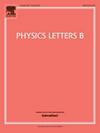Curvature corrections to Starobinsky inflation can explain the ACT results
IF 4.5
2区 物理与天体物理
Q1 ASTRONOMY & ASTROPHYSICS
引用次数: 0
Abstract
We investigate the impact of curvature corrections to Starobinsky inflation in light of the latest observational results from the Atacama Cosmology Telescope (ACT). While the pure Starobinsky model remains a compelling candidate for cosmic inflation, we explore how the higher-order curvature terms , and modify the inflationary predictions. Using the scalar-tensor formulation of gravity, we derive the effective scalar potentials and compute the resulting scalar tilt , its running index and the tensor-to-scalar ratio . We show that those curvature corrections can shift the predictions to align better with the ACT data, thus providing a possible resolution to a minor discrepancy between the standard Starobinsky model and ACT observations. Our findings suggest that the modified Starobinsky models with the higher-order curvature terms offer a viable pathway to reconciling inflationary predictions with precision cosmological measurements. At the same time, measuring or constraining primordial tensor modes can help to discriminate between these corrections.
对斯塔宾斯基膨胀的曲率修正可以解释ACT的结果
根据阿塔卡马宇宙望远镜(ACT)的最新观测结果,我们研究了曲率修正对Starobinsky暴胀的影响。虽然纯粹的Starobinsky模型仍然是宇宙暴胀的一个令人信服的候选者,但我们探索了高阶曲率项R3, R4和R3/2如何修改暴胀预测。利用f(R)引力的标量张量公式,我们推导了有效标量势,并计算了由此产生的标量倾斜度ns、运行指数αs和张量-标量比R。我们表明,这些曲率修正可以使预测更好地与ACT数据一致,从而为标准Starobinsky模型和ACT观测之间的微小差异提供了可能的解决方案。我们的发现表明,带有高阶曲率项的修正斯塔宾斯基模型为调和暴胀预测与精确的宇宙测量提供了一条可行的途径。同时,测量或约束原始张量模可以帮助区分这些修正。
本文章由计算机程序翻译,如有差异,请以英文原文为准。
求助全文
约1分钟内获得全文
求助全文
来源期刊

Physics Letters B
物理-物理:综合
CiteScore
9.10
自引率
6.80%
发文量
647
审稿时长
3 months
期刊介绍:
Physics Letters B ensures the rapid publication of important new results in particle physics, nuclear physics and cosmology. Specialized editors are responsible for contributions in experimental nuclear physics, theoretical nuclear physics, experimental high-energy physics, theoretical high-energy physics, and astrophysics.
 求助内容:
求助内容: 应助结果提醒方式:
应助结果提醒方式:


